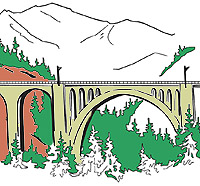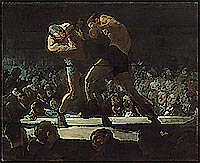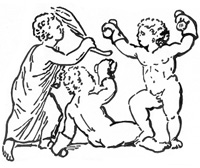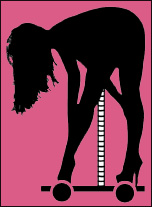Much of the information from mapping is repeated here.
This is a game design that is not developed. The player is the developer. Practice setting up and moving units around the battlefield by drawing cards. The fact that you have designed the battlefield should help this learning process and give an appreciation for the terrible situation of a field marshal or general in the Black Powder Era. [1]
The actual battle is broken into three phases:
-Pathos: Unit Activation and Actions [2]
-Chaos: Cards, Combat Results, Flanking, Objectives & Momentum
-Panic: Losses, Retreat, Restoration, Unit Breaking and Army Morale
The rout of an army that does not maintain its spirit through the Panic Phase, and its subsequent pursuit, are the subject of Chapter 5: Rout.
The Pathos [2] Phase begins with the shuffling of the deck by the Fortunate Player, the cutting of the deck by the Unfortunate Player, and the dealing of 7 cards to each player by the Fortunate Player. These 7 cards are the extent of your coordinated planning. [2] Take some time to consider them. In a game with multiple players on each side, the Unfortunate Players repair to a side room and divide the cards and discuss their battle plan while the Fortunate Players do the same over the play table.
A battle is resolved in rounds of simultaneous action. Each round of combat, of which there may be many, begins with each player laying out a card. This card is used to give commands to units. The card of the lowest suit acts first:
-Clubs
-Diamonds
-Hearts
-Spades
In case the same suit has been played by each player, the low card goes first.
A Clubs card may activate units with the penny token.
A Diamonds card activates only units with the nickle token.
A Hearts card activates only units of the dime token.
A Spades card may activate units of any token.
Note that the most common unit is a penny, representing the lowest classes of combatant, and that it may be difficult to activate all of these units. Keep this in mind during set up.
Unit activation cost uses the same values as in marshaling.
Battery: 6
Battalion: 4
Troop: 3
Company: 2
Recall the values of the cards:
2 thru 10
-Jack = 11
-Queen = 12
-King = 14
-Ace = 15
-Low Joker = 16
-High Joker = 17
So, a deuce of clubs may only move a company of irregular foot.
A Jack of Spades may activate 11 points worth of units from any suit.
Units are activated one at a time, unless a card dictates otherwise. [See Chaos Phase]
Once activated, a unit may:
-Move at full rate
-Fire at full power and full range
-Move half rate and fire at half power and half range
-Fire at half power and half range and move at half rate
Note that range reduction will also decrease firepower as described below under Firepower & Range.
Movement Rates
Battery = 2
Battalion in Line = 3
Battalion in Column = 4
Company of Foot = 5
Troop of Horse = 6
Battalions that end their movement with 1 point remaining, that are at least one domino away from an enemy unit, may reform from line to column or from column to line.
Elevations
All unit types are impeded while gaining elevation.
A decrease in elevation does not impede.
Once upon an elevation, movement is not impeded.
Note: since a battery has but 2 movement, it may not move onto an eminence unless a card is pulled that facilitates increased movement. Hence the importance of placing batteries upon high ground during the marshaling phase.
Habitations
Villages, farms and manors have played more important battle roles in the Age of Gun Powder than in ancient or medieval warfare. These are worth occupying and have no negative effect on movement, with one exception: When a habitation is placed straddling a creek, then unit crossing is only impeded if an enemy unit occupies the far side of the bridge that is assumed to be there, and may indeed be the village’s reason for being.
…
Woods
Battery = blocked [May be placed in the marshaling phase facing out of a wood.]
Battalion in line = impeded
Battalion in column = blocked
Company of Foot = impeded
Troop of Horse = impeded
…
Creek
Battery = blocked
All other types = Impeded
…
Swamp or Marsh
Battery = blocked
Battalion = blocked [This has as much to do with the rigid hierarchical social condition of the unit as with its heavier weapons.]
Company of Foot = impeded
Troop of Horse = impeded
Lakes
This feature is impassible by all units within the time scale of the game. Water crossings by boat may be represented in the marshaling phase, by placing Companies with their back to the lake. Only companies may be deployed in such a fashion.
…
Cover
This concept is purely defensive and represents a terrain feature’s defensive value to units occupying it when fired upon. In the Black Powder Era, from 1648 to 1815, most units have firepower, excepting only some types of horse. Firepower is here broken into only two types:
-1. battery
-2. musketry
Cover is expressed by the defender having the option of having the attacker set aside the card drawn and draw another, something usually expressed in re rolls in table top games.
All types of terrain occupied by a unit being fired upon grant cover equally against battery and musketry, except that a habitation has no defensive value against battery fire, the easily sighted buildings providing shrapnel for the cannonballs.
A unit occupying two types of terrain, such as a creek and village, or a forested elevation, has a second option of having the firing player pick an alternate card.
Action mechanics and values are listed below.
Card use and combat results are covered under Chaos.
Losses, retreat, forced marching, morale and restoration are covered under Panic, as well as play options for additional players and components.
Firepower and Range
The firepower is based on the value on the dice or domino, which represents the manpower of the unit and may be reduced through action. The first number is the range, followed by a multiplier or divisor.
While movement is regulated by using the length of the blank domino, firing range is measured by using the width of the domino.
Battery Range & Effect
Batteries are the dominoes with a blank and are placed with the blank side representing the rear, where the unit may not fire. It may fire to either side at half power. When and if retreating, batteries must wheel around with the blank to their rear. Getting away from a lost battle with one’s canon was nearly a magic trick. It costs a point to wheel in part or full.
0 = x 6
1 = x 5
2 = x 4
3 = x 3
4-5 = x 2
6-9 = x 1
10-12 = ½
13-14 = ¼
Batteries must either move or fire and may not split actions like other units. Batteries may also, not move to within 0 range.
0 range is when the units are either touching or less than one domino width apart. There is a closer range than 0, which is discussed at the end of this section. A battery may defensively engage inc close combat. The men that manned guns often defended them with sabers, one of which I examined in 2017, with defensive nicks in the fort of the blade.
…
Battalion Range & Effect
Line
0 = x 2
1 = x 1
2 = ½
3-4 = ¼
Column
0 = x1
1 = ½
2-4 = ¼
These weapons are muskets, un-rifled and used in mass due to their inaccuracy. Civil War and Colonial battles will have adjustments.
…
Company Range & Firepower
0 = x 2
1-2 = x 1
3-4 = ½
5-6 = ¼
These represent sharp shooters, rangers, Indians, riflemen and jaegers, using weapons that may be employed for targeting officers.
…
Troop Range & Firepower
0 = x 1
1 = x ½
2 = x ¼
Firearms used from horseback include pistols and carbines are used for close range fire and are not used by elite horsemen, signified by the hearts and spades cards and dime and quarter token, which only engage in close combat. Horsemen with firearms were often dragoons or hobilers, or pistol armed men who ride up and fire into the face of the enemy, behaving more like an ancient horse archer, a type that comes into play in the American Civil War.
…
Close Combat
When a unit wishes to come to grips with an enemy unit and has enough movement left that it could move into or through the space occupied by the defender, the player declares close combat intent.
The defending player has three options:
-1. Retreat with any unit that has a higher movement rate, by moving back one full domino.
-2. Fire at the advancing unit at full power with 0 range multiplier.
-3. Accept combat.
Once units have met, the advancing player touches his unit to the other and slides his coin over to connect both. If the defending player accepts combat both coins are crossed. These units may not elect to move or be commanded to do so while in contact and may only break contact as a result of combat. For the advancing unit that has crossed coins, there is an advantage in combat with a unit that fired instead of accepting combat. This is covered under Chaos.
An advancing unit that has driven off a defender, and has remaining movement, may continue to advance, but, not past other enemy units that are close enough to engage in close combat. This unit may engage such units that were next to the retreating unit from the flank. Flanking is covered under Chaos.
Close combat is also governed by the advantage of defensive terrain repeated below from the mapping section.
…
Advantage
This concept concerns hand to hand combat; the crossing of bayonets, lances and sabers, and the vicious aspects of tribal warfare in the American Revolution.
Any charge up an elevation grants advantage to the defender, as the charge down an elevation grants it to the attacker.
The interaction of troop types within vegetation and habitation zones is more complicated. In hand to hand combat, the advantage schemes below will determine what unit type has the advantage.
Advantage is expressed as an additional card draw, with the advantage player taking two cards and playing both. The first type listed has advantage over all others below. [3]
When occupying two types of terrain the defender decides which terrain type governs advantage.
…
Charging Horsemen
Charging horsemen must move one space, and have their strength increased by every unexpended movement point. A horse unit with a 2 strength, which moves 1 space and has 5 unexpended movement points, attacks as a 7.
Open Terrain
Battalion in Column
Battalion in line
Troop of Horse
Company of Foot
Battery
Habitation
Battalion in Line
Battery
Company of Foot
Battalion in Column
Troop of Horse
…
Woods
Battery [It can be set facing from a wood in the marshaling face, but may not move.]
Company of Foot
Battalion in Line
Battalion in Column
Troop of Horse
Creek
Battalion in Line
Battery
Company of Foot
Battalion in Column
Troop of Horse
…
Swamp and Marsh
Troop of Horse: [From Teutonic Knights to Mounted Kentucky Militia, horsemen have proven effective in wetlands, in part because their powder stayed drier than footmen and horses can swim, when many men cannot.] Troops of Horse may not charge in swamp. So there is no double advantage.
Company of Foot
Battalion in Line
Battalion in Column
…
Bridge
[Where a creek and habitation intersect.]
-Battery
-Battalion in Column
-Troop of Horse
-Company of Foot
-Battalion in Line
Combat Resolution
Where most wargames rate the effect of fire or close combat, with die rolls, Battle uses playing cards. This is covered under Chaos.
The results of those effects are covered under Panic.
…
Notes
-1. I suggest viewing the following battle movies: Alexander, The Last Valley, Waterloo, the TV series Sharp’s Rifles, Heaven and Earth [Japanese], Gods & Generals and Zulu Dawn.
-2. This phase is the expression of the War Council, the imposition of the will of the commander and his generals and men on the battlefield and the enemy. This phase ends for each player, when their card hand is expended. This may not happen in the same round.
-3. Like a re roll on dice games.











